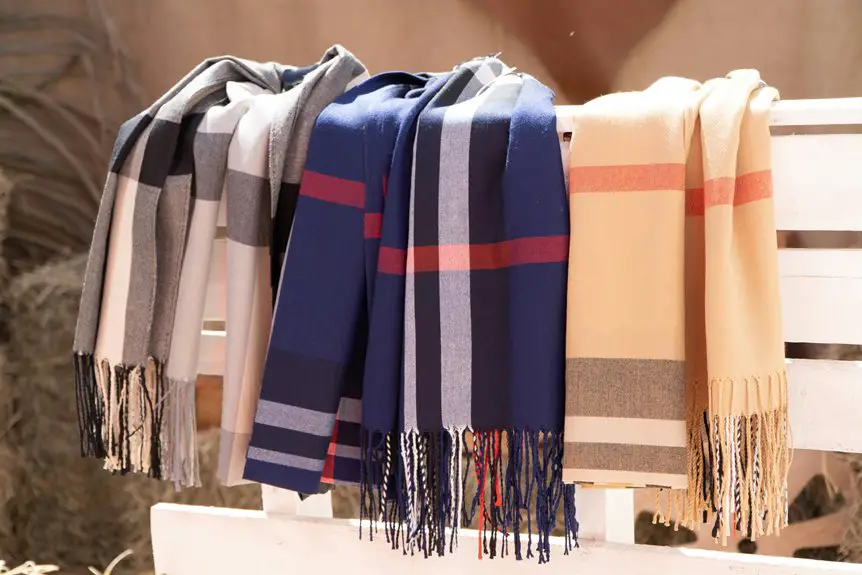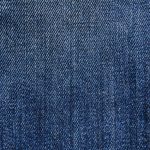When choosing between interlock and piqué fabric, you’ll find interlock is thicker, stretchy, and smooth on both sides, ideal for activewear and everyday comfort. Piqué offers a textured, breathable surface with a structured fit, perfect for polos and casual blazers. Interlock resists stretching and pilling better, while piqué handles heat and airflow well. Both need gentle care but differ in cost and environmental impact. Keep exploring to discover which fabric truly suits your apparel needs.
Table of Contents
Key Takeaways
- Interlock fabric is double-knit, thicker, and more stable, while piqué features a textured, double-weave pattern with raised designs.
- Interlock offers excellent stretch and shape retention; piqué provides a structured fit with less stretch and slower recovery.
- Piqué’s textured knit enhances breathability and moisture evaporation, making it better for warm conditions than the moderately breathable interlock.
- Interlock resists pilling and abrasion for activewear durability; piqué is durable but prone to snagging in high-friction areas.
- Interlock is generally more expensive with a higher water footprint; piqué is cost-effective, widely available, and ideal for polo shirts and casual blazers.
Understanding the Construction of Interlock Fabric
Interlock fabric features a unique double-knit construction that makes it thicker and more stable than single-knit fabrics. When you work with interlock, you’re dealing with two layers of fabric knitted together, which means it won’t easily stretch out or lose shape.
You’ll notice both sides look smooth, unlike other knits where one side might be different from the other. This double-knit design also gives interlock a bit of natural stretch, making it comfortable for apparel that needs flexibility without sagging.
If you need a fabric that holds up well after washing and resists pilling, interlock is a smart choice. By understanding its construction, you can better decide when interlock suits your project’s durability and comfort needs.
Exploring the Texture and Weave of Piqué Fabric
Piqué fabric stands out with its distinctive textured surface, created by a weaving technique that forms raised patterns like cords or waffles. When you touch piqué, you feel those tiny, raised bumps that give it a structured yet breathable quality.
This texture comes from a double-weave construction, where the yarns interlace in a way that creates the fabric’s signature three-dimensional effect. Unlike smooth knits, piqué’s weave adds visual interest and tactile depth, making it popular for polo shirts and sportswear.
As you work with piqué, you’ll notice it holds shape well without being stiff, thanks to its unique weave. This texture not only enhances appearance but also improves airflow, keeping garments comfortable during wear.
Comparing Stretch and Flexibility Between Interlock and Piqué
You’ll notice interlock fabric stretches more easily and bounces back quickly, making it great for activewear.
Piqué offers less stretch but provides a structured fit that holds its shape well.
Understanding these differences helps you choose the best fabric for comfort and style.
Stretch Recovery Rates
Although both fabrics offer some degree of stretch, their recovery rates differ noticeably.
When you stretch interlock fabric, it quickly bounces back to its original shape thanks to its tightly knit structure. This makes it ideal if you want garments that maintain a crisp, smooth appearance after wear.
Piqué fabric, on the other hand, has a looser knit with a textured surface, causing it to recover more slowly after stretching. You might notice some lingering looseness or slight sagging over time, especially in high-stress areas.
Flexibility in Garment Fit
Understanding how each fabric stretches and recovers helps set the stage for comparing their overall flexibility in garment fit.
When you choose interlock, you get a fabric that offers excellent stretch and bounce-back, making it ideal for garments that need to move with the body. Its double-knit construction allows it to mold comfortably without losing shape.
On the other hand, piqué provides a more structured fit with less stretch. While it offers durability and a crisp look, it won’t adapt as much to your movements.
Breathability and Moisture Management in Both Fabrics
When you wear Interlock or Piqué fabric, their breathability and moisture management play a big role in your comfort.
Interlock’s tight knit makes it slightly less breathable, but it still allows decent airflow, keeping you comfortable during moderate activity. Its smooth surface also helps wick moisture away from your skin, preventing that sticky feeling.
Interlock’s tight knit offers moderate breathability and smooth moisture-wicking comfort for everyday wear.
On the other hand, Piqué’s textured knit creates tiny air pockets that enhance breathability, making it ideal for warmer conditions or activewear. It excels at moisture management by promoting quick evaporation, so you stay drier longer.
Depending on your needs—whether you want a softer feel or better airflow—you can choose the fabric that best manages moisture and breathability to keep you comfortable throughout the day.
Durability and Longevity: How They Stand Up Over Time
You’ll want to know how interlock and piqué fabrics hold up after repeated wear and washing.
Comparing their resistance to wear and how their strength changes over time helps you choose the best option.
Plus, understanding how maintenance affects durability guarantees your fabric lasts longer.
Wear Resistance Comparison
Both interlock and piqué fabrics offer reliable durability, but they handle wear differently depending on their structure and use.
When you choose interlock, you get a smooth, tightly knit fabric that resists pilling and abrasion well, making it ideal for everyday wear and active garments.
Piqué’s textured, raised pattern provides excellent air circulation but can be more prone to snagging and surface wear, especially in high-friction areas.
If your apparel faces frequent rubbing or rough conditions, interlock generally outperforms piqué in maintaining a clean, intact surface.
However, if you prioritize breathability and a classic look, piqué holds up well with moderate wear.
Understanding these differences helps you select the fabric that best matches your garment’s intended activity and lifespan needs.
Fabric Strength Over Time
Understanding how interlock and piqué fabrics wear helps set the stage for examining their strength over time.
When you choose interlock, you get a fabric that maintains its shape and resists stretching, thanks to its tightly knit double layers. This means your garments hold up well through repeated use.
On the other hand, piqué’s textured weave offers excellent durability, especially in structured apparel like polos, where the fabric’s firmness resists sagging.
Over time, you’ll notice interlock’s smooth surface stays intact without pilling, while piqué’s raised pattern may soften but won’t easily tear.
Both fabrics offer solid longevity, but your choice depends on whether you prioritize consistent elasticity or a resilient, textured finish that ages gracefully under regular wear.
Maintenance Impact on Durability
Although interlock and piqué fabrics each have strong natural durability, how you care for them greatly affects their lifespan. You’ll want to wash both fabrics gently—cold water and a mild detergent work best to prevent fiber damage.
Avoid harsh chemicals and bleach, which weaken the fabric’s structure over time. Interlock fabric benefits from air drying or low heat in the dryer to maintain its softness and shape.
Piqué, being slightly thicker and textured, can tolerate a bit more heat but still fares best with gentle drying to avoid shrinkage. Regularly following these care steps helps preserve the fabric’s integrity, so your garments stay durable and look great longer, saving you money and effort in the long run.
Ideal Garment Types for Interlock Fabric
When you choose interlock fabric for your garments, you tap into a material known for its smooth texture and excellent stretch recovery. This makes it perfect for close-fitting apparel like t-shirts, leggings, and underwear, where comfort and flexibility matter most.
You’ll also find interlock ideal for baby clothes, thanks to its softness and gentle feel against sensitive skin. Additionally, it suits casual dresses and skirts that benefit from a bit of stretch without losing shape.
If you’re designing activewear, interlock’s breathability and durability come in handy, providing support during movement. Overall, interlock fabric works best where a soft, stretchy, and stable knit is needed, helping you create garments that feel great and maintain their form wear after wear.
Best Uses for Piqué Fabric in Apparel Design
Piqué fabric shines in apparel design where texture and durability are key. You’ll find it perfect for polo shirts, sportswear, and casual blazers due to its breathable yet structured feel. Its signature waffle-like texture adds visual interest, making it ideal for garments that need both comfort and style.
| Garment Type | Benefits | Ideal Occasion |
|---|---|---|
| Polo Shirts | Breathable, durable | Casual, sports events |
| Sportswear | Moisture-wicking, flexible | Activewear |
| Casual Blazers | Structured, textured | Smart casual outings |
When you choose piqué, you get a fabric that holds shape well and offers timeless appeal, especially in classic and sporty wardrobe staples.
Care and Maintenance Requirements for Both Fabrics
Since interlock and piqué fabrics differ in texture and structure, their care routines also vary to keep them looking their best.
You should wash interlock fabric on a gentle cycle with cold water to prevent stretching or shrinking. Avoid bleach, and tumble dry on low or air dry to maintain its softness and shape.
For piqué fabric, use a mild detergent and wash it inside out to protect its textured surface. It’s best to avoid high heat in both washing and drying, as piqué can lose its crispness.
Iron piqué on a medium setting if needed, while interlock rarely requires ironing due to its smooth finish.
Following these steps will help you preserve the durability and appearance of both fabrics in your apparel creations.
Cost Considerations When Choosing Between Interlock and Piqué
Although both interlock and piqué fabrics offer quality and comfort, you’ll find that their costs can vary considerably depending on factors like material composition, manufacturing complexity, and brand.
Interlock, often made from fine cotton or blends, tends to be pricier due to its double-knit structure, which requires more yarn and time to produce.
Interlock’s double-knit structure demands more yarn and time, making it a pricier fabric choice.
Piqué, with its textured weave, usually costs less and is more widely available, making it a budget-friendly option.
However, if you’re aiming for premium blends or organic fibers, expect higher prices for both.
Remember, your choice should balance cost with the desired fabric performance and look.
Factoring in your target market’s expectations helps guarantee your investment aligns with your apparel line’s positioning.
Environmental Impact and Sustainability Factors of Each Fabric
When evaluating interlock and piqué fabrics, you should consider their environmental impact alongside cost and performance. Both fabrics often use cotton, which can demand significant water and pesticide use. However, sustainable sourcing can mitigate this.
Here’s what to keep in mind:
- Water footprint: Interlock, with its denser knit, may require more water in production than piqué.
- Chemical use: Conventional cotton in both fabrics often involves pesticides, but organic options reduce this.
- Durability: Interlock’s thickness can extend garment life, lowering environmental costs from frequent replacements.
- Recycling potential: Piqué’s structure sometimes allows easier recycling or upcycling compared to interlock.
Choosing fabrics with certifications like GOTS or OEKO-TEX can further guarantee you’re making eco-friendlier apparel decisions.
Frequently Asked Questions
Can Interlock and Piqué Fabrics Be Blended Together in a Single Garment?
You can blend interlock and piqué fabrics in one garment to combine softness and texture. Just make certain to take into account their different stretch and weight properties to guarantee comfort and durability in your design.
Which Fabric Is Better Suited for Printing or Embroidery?
When it comes to your designs, interlock acts like a blank canvas, making it better for printing with smooth surfaces. Piqué’s textured weave shines brighter with embroidery, adding depth and character to your stitched art.
How Do These Fabrics Perform in Extreme Weather Conditions?
You’ll find interlock fabric keeps you warmer in cold weather due to its thickness, while piqué excels in hot conditions with its breathability and moisture-wicking. Choose based on your specific weather needs.
Are There Specific Brands Known for High-Quality Interlock or Piqué Fabrics?
Several standout suppliers specialize in superb, sturdy fabrics. Look to brands like Sol’s for solid interlock and Lacoste for premium piqué. You’ll find fantastic finishes fueling your fashion forward designs effortlessly.
What Are the Common Allergens Associated With Each Fabric Type?
You might react to chemicals used in fabric finishing or dyes in both types. Interlock’s tight weave may trap allergens less, while piqué’s texture can irritate sensitive skin. Always check for hypoallergenic certifications.
- What Is the Difference Between Cotton and Cotton Percale? - July 14, 2025
- What Is Italian Percale? Exploring a Mark of Luxury - July 14, 2025
- Is Percale Better Than Cotton? A Misleading Question Explained - July 14, 2025







